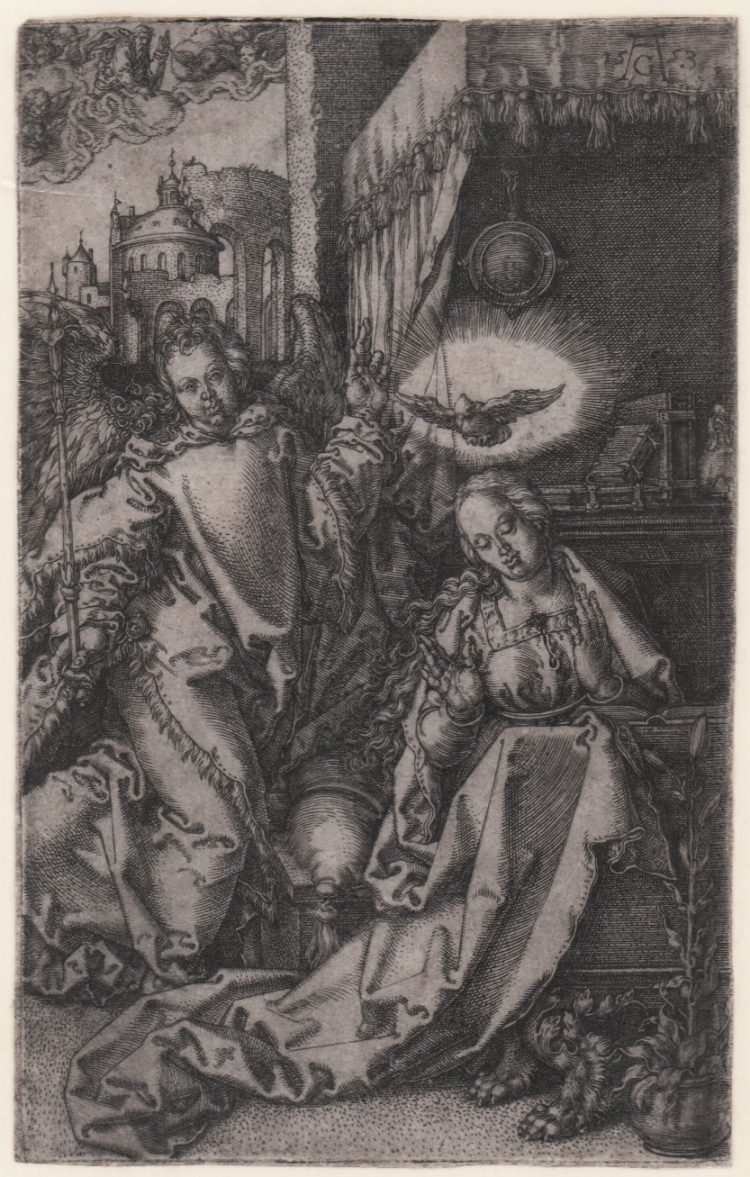




| Reference: | S11800 |
| Author | Heinrich ALDEGREVER |
| Year: | 1553 |
| Measures: | 68 x 108 mm |



| Reference: | S11800 |
| Author | Heinrich ALDEGREVER |
| Year: | 1553 |
| Measures: | 68 x 108 mm |
The annunciation; the Virgin kneeling at right in frontal view; the Holy Spirit as a dove above her; the Archangel Gabriel at l, his left hand raised in a blessing; view of an interior covered by a baldachin at right; at left a landscape with a castle.
Engraving, 1553, signed with monogram and dated at upper right.
Shortly before 1520, some young artists in Albercht Dürer's circle took to making very small engravings that challenged the viewer with a miniature world of new secular subject matter and unconventional interpretations of traditional themes. Because of the small size of their engravings, these artists have long been affixed with the collective, and unflattering, name of Small Nuremberg Masters. The core of the group consists of three artists from Nuremberg, Hans Sebald & Bartel Beham and Georg Pencz, and in addition Jacob Bink from Cologne and Heinrich Aldegrever from Soest.
Excellent work, rich in shades, printed on contemporary laid paper without watermark, trimmed to platemark, repair on right margin perfectly executed, in general in good condition.
Bibliografia
New Hollstein (German), The New Hollstein: German engravings, etchings and woodcuts 1400-1700 (38); Bartsch, Le Peintre graveur (VIII.373.38).
Heinrich ALDEGREVER (Paderborn, 1502; Soest, Westfalia, 1555–61)
|
German engraver, painter and designer. He was the most important graphic artist in Westphalia in the 16th century. His reputation rests largely on his ornamental designs, which make up about one third of his c. 300 engravings. They were principally intended as models for metalworkers but were also adapted by other craftsmen for such decorative arts as enamel, intarsia and book illustration. Aldegrever followed Dürer and the Nuremberg LITTLE MASTERS, deriving models for his paintings and subject prints as well as a full repertory of Renaissance ornamental motifs: fig and acanthus foliage, vases and cornucopia, combined with putti and satyrs, tritons, mermaids and dolphins, sphinxes, masks and medallions. From the beginning of his career Aldegrever was aware of the artistic trends of the time: the Dürer influence was strongest at its outset yielding somewhat in work of the 1530s to Mannerist tendencies under Netherlandish influence, though never waning entirely.
|
Heinrich ALDEGREVER (Paderborn, 1502; Soest, Westfalia, 1555–61)
|
German engraver, painter and designer. He was the most important graphic artist in Westphalia in the 16th century. His reputation rests largely on his ornamental designs, which make up about one third of his c. 300 engravings. They were principally intended as models for metalworkers but were also adapted by other craftsmen for such decorative arts as enamel, intarsia and book illustration. Aldegrever followed Dürer and the Nuremberg LITTLE MASTERS, deriving models for his paintings and subject prints as well as a full repertory of Renaissance ornamental motifs: fig and acanthus foliage, vases and cornucopia, combined with putti and satyrs, tritons, mermaids and dolphins, sphinxes, masks and medallions. From the beginning of his career Aldegrever was aware of the artistic trends of the time: the Dürer influence was strongest at its outset yielding somewhat in work of the 1530s to Mannerist tendencies under Netherlandish influence, though never waning entirely.
|